 Dover, New Hampshire, September 11, 2015 — Today, U.S. Secretary of the Interior Sally Jewell announced that a public-private partnership uniting foresters, farmers, birdwatchers, biologists, hunters and other conservationists has saved the New England cottontail from needing protection under the Endangered Species Act. The partnership has also initiated on-the-ground conservation efforts for the cottontail that will benefit the rabbit into the future.
Dover, New Hampshire, September 11, 2015 — Today, U.S. Secretary of the Interior Sally Jewell announced that a public-private partnership uniting foresters, farmers, birdwatchers, biologists, hunters and other conservationists has saved the New England cottontail from needing protection under the Endangered Species Act. The partnership has also initiated on-the-ground conservation efforts for the cottontail that will benefit the rabbit into the future.
Read more HERE


 At the end of January (2014), the New Hampshire Business Review featured a front-page article about the economic costs of invasive species in New Hampshire. In August of 2013, a team of researchers, including UNH professor Larry Harris, did a one-day sweep of several sites in along the New Hampshire coast searching for non-native plants and animals. Their effort included stops at Hampton River Marina and the Coastal Marine Laboratory, a UNH facility in New Castle. Researchers have been conducting these sweeps every 3 years since 2000. And while this year, no new introduced species were discovered, the team saw that the composition of communities was changing with higher relative abundances of some established invasive species. For example the invasive sea squirt called ciona, has become a dominant species at places like the Hampton River Marina. These creatures wreak havoc on aquaculture; clogging nets, fouling the netting of cages, and overgrowing mussels. Another dominant invasive species to inhabit the coastal waters of New Hampshire and New England is didemnum (another type of sea squirt). Didemnum is a serious marine pest, growing in thick, sheet-like colonies that attach to anything they can get a hold of, moorings, docks, boat ramps, etc.. They also clog intakes to cooling systems of water treatment plants.
At the end of January (2014), the New Hampshire Business Review featured a front-page article about the economic costs of invasive species in New Hampshire. In August of 2013, a team of researchers, including UNH professor Larry Harris, did a one-day sweep of several sites in along the New Hampshire coast searching for non-native plants and animals. Their effort included stops at Hampton River Marina and the Coastal Marine Laboratory, a UNH facility in New Castle. Researchers have been conducting these sweeps every 3 years since 2000. And while this year, no new introduced species were discovered, the team saw that the composition of communities was changing with higher relative abundances of some established invasive species. For example the invasive sea squirt called ciona, has become a dominant species at places like the Hampton River Marina. These creatures wreak havoc on aquaculture; clogging nets, fouling the netting of cages, and overgrowing mussels. Another dominant invasive species to inhabit the coastal waters of New Hampshire and New England is didemnum (another type of sea squirt). Didemnum is a serious marine pest, growing in thick, sheet-like colonies that attach to anything they can get a hold of, moorings, docks, boat ramps, etc.. They also clog intakes to cooling systems of water treatment plants.
